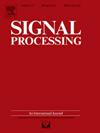Reconfigurable intelligent surface-enabled gridless DoA estimation system for NLoS scenarios
IF 3.4
2区 工程技术
Q2 ENGINEERING, ELECTRICAL & ELECTRONIC
引用次数: 0
Abstract
The conventional direction-of-arrival (DoA) estimation approaches are effective only when the line-of-sight (LoS) link is available. In non-line-of-sight (NLoS) scenarios, it is challenging to effectively obtain the directional information of targets due to the uncontrollability of signal reflections from NLoS links. To handle this issue, a novel reconfigurable intelligent surface (RIS)-enabled gridless DoA estimation system for NLoS scenarios is proposed, where the RIS establishes a virtual LoS link between the base station and targets. First, considering the minable statistics of the signal, the RIS-enabled signal model in the covariance domain with a limited number of receiving antennas is proposed to help reduce resource consumption. Next, we estimate the noise variance by constraining the Frobenius norm of the measurement error matrix to enhance the robustness to noise. Then, we reconstruct the Hermitian Toeplitz matrix by addressing the atom norm minimization (ANM) problem on the covariance-noiseless matrix. To reduce the computation, an efficient iterative approach is designed via the alternating direction method of multipliers. Furthermore, this system’s Cramér–Rao lower bound is derived, which is further exploited as the DoA estimation’s reference bound. Numerical experiments validate the superiority of the proposed system over the benchmark in terms of computational efficiency and estimation precision.
面向NLoS场景的可重构智能地面无网格方位估计系统
传统的到达方向(DoA)估计方法只有在视距(LoS)链路可用时才有效。在非视距(NLoS)场景下,由于非视距链路信号反射的不可控性,给有效获取目标方向信息带来了挑战。为了解决这一问题,提出了一种基于可重构智能表面(RIS)的NLoS场景无网格DoA估计系统,该系统在基站和目标之间建立虚拟的LoS链路。首先,考虑到信号的可统计性,在接收天线数量有限的情况下,提出了在协方差域中使能ris的信号模型,以减少资源消耗。其次,我们通过约束测量误差矩阵的Frobenius范数来估计噪声方差,以增强对噪声的鲁棒性。然后,通过解决协方差-无噪声矩阵上的原子范数最小化(ANM)问题,重构了厄米特Toeplitz矩阵。为了减少计算量,利用乘法器的交替方向法设计了一种高效的迭代方法。在此基础上,推导了系统的cram r - rao下界,并将其作为DoA估计的参考界。数值实验验证了该系统在计算效率和估计精度方面优于基准系统。
本文章由计算机程序翻译,如有差异,请以英文原文为准。
求助全文
约1分钟内获得全文
求助全文
来源期刊

Signal Processing
工程技术-工程:电子与电气
CiteScore
9.20
自引率
9.10%
发文量
309
审稿时长
41 days
期刊介绍:
Signal Processing incorporates all aspects of the theory and practice of signal processing. It features original research work, tutorial and review articles, and accounts of practical developments. It is intended for a rapid dissemination of knowledge and experience to engineers and scientists working in the research, development or practical application of signal processing.
Subject areas covered by the journal include: Signal Theory; Stochastic Processes; Detection and Estimation; Spectral Analysis; Filtering; Signal Processing Systems; Software Developments; Image Processing; Pattern Recognition; Optical Signal Processing; Digital Signal Processing; Multi-dimensional Signal Processing; Communication Signal Processing; Biomedical Signal Processing; Geophysical and Astrophysical Signal Processing; Earth Resources Signal Processing; Acoustic and Vibration Signal Processing; Data Processing; Remote Sensing; Signal Processing Technology; Radar Signal Processing; Sonar Signal Processing; Industrial Applications; New Applications.
 求助内容:
求助内容: 应助结果提醒方式:
应助结果提醒方式:


